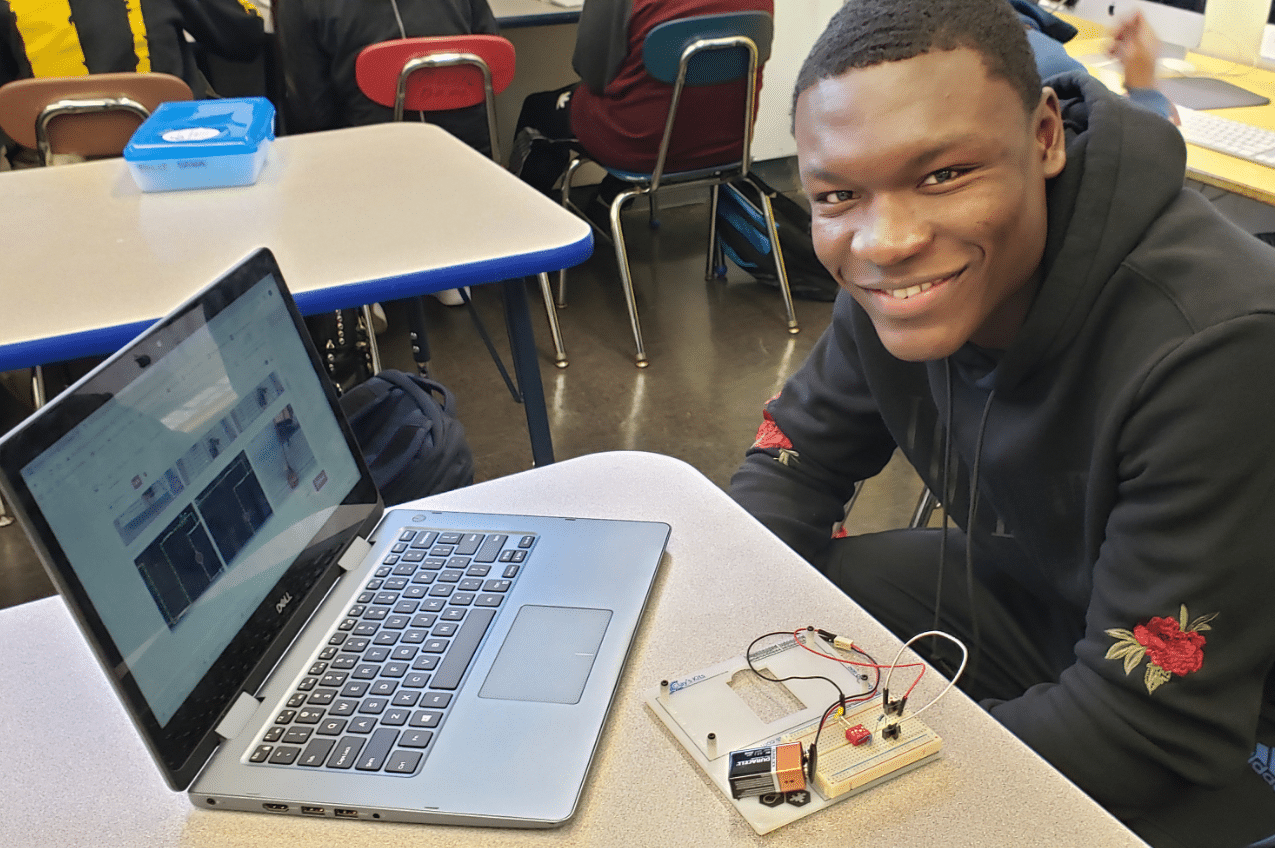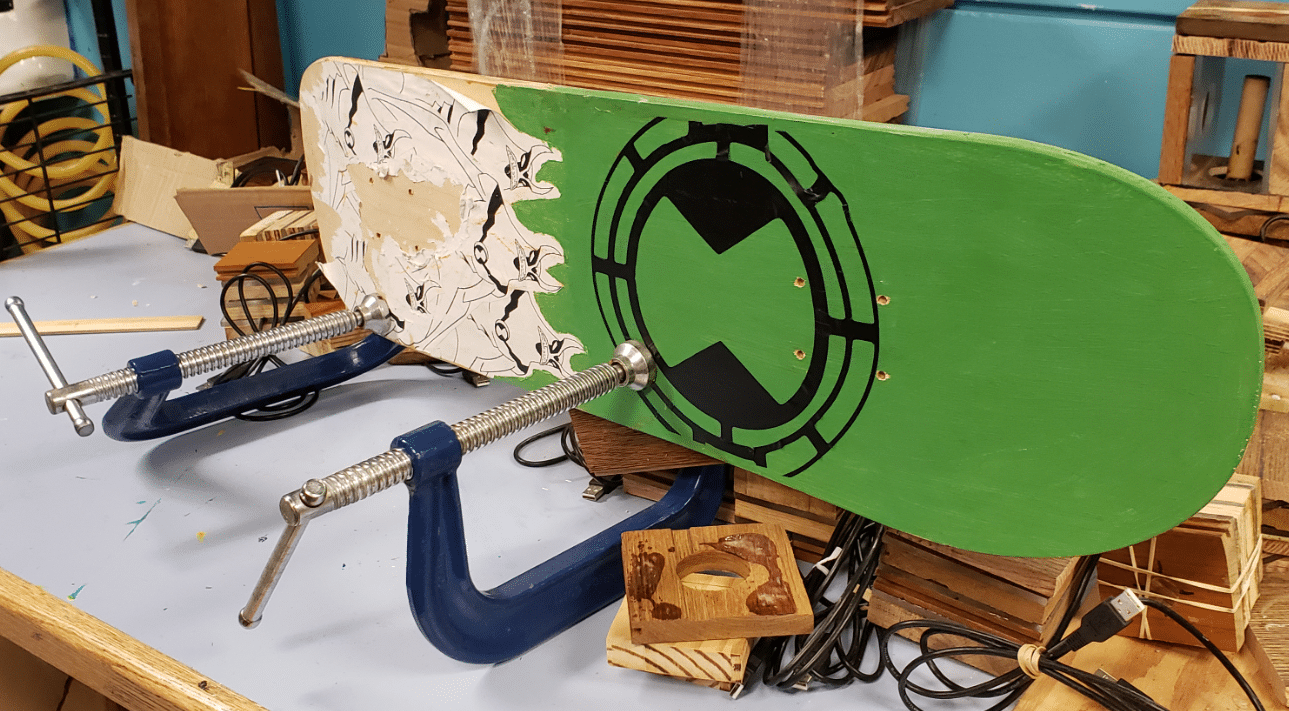Mastery-Based Making: The Urban Assembly Maker Academy
CompetencyWorks Blog
 This is the third post in a series about the Mastery Collaborative in New York City. Links to the other posts can be found at the end of this article.
This is the third post in a series about the Mastery Collaborative in New York City. Links to the other posts can be found at the end of this article.
Urban Assembly Maker Academy is a New York City public high school with a well-developed mastery system, one of the model “Living Lab” schools for the Mastery Collaborative, an organization described in the first post in this series. The school has many well-developed elements of competency-based education that could serve as models for other schools.
Projects in the maker classroom this school year include students creating original designs in everything from skateboards to sneakers to mobile apps. The maker classroom teacher, Gerry Irizarry, whose former work was in the design field, says that the most important take-away is the design thinking students are learning, which can be applied to any industry—not the specifics of mobile apps or skateboards.
The school is based on the belief that “the world needs problem solvers who can find out and solve challenges to create positive change in a world where change is the only constant. We empower students to be successful, adaptive citizens of the future, who will create the future through design thinking and innovation. Our students are curious about the world around them and empathize with others to develop personalized solutions. Our students know that to innovate, they must take risks. They measure the impact of their actions. They overcome challenges with resilience.”
 CTE Pathways in a Competency-Based System
CTE Pathways in a Competency-Based System
The school has two approved career and technical education pathways: computer science and digital media. Students in the computer science pathway take courses including video game programming, physical computing, and Python programming. These courses connect with projects such as creating an interface like Pandora, the app that creates music playlists and “radio stations” based on user preferences. Students in the digital media pathway take courses including digital animation, design studio, and prototyping. These course sequences, as well as the school’s advisory and academic courses are shown in the UA Maker Course Sequence graphics.
The staff of UA Maker demonstrate how devotion and persistence can create opportunities for active, engaging learning within complex local and state education regulations. Administrators explained that it took them four years to receive permission for students to pursue the school’s two CTE-approved pathways. During that time, the guidance the school received about the state’s CTE requirements shifted multiple times, so the school would change their course offerings and sequence to comply and then need to change them again. In the end, they have a system that students are excited about and that is leading to strong student outcomes.
The Design Process and Assessment
UA Maker’s mission statement is closely linked to the design thinking process that Gerry emphasized in the maker classroom. The school explains that design thinking is “a critical thinking process that allows people to solve challenges,” and learning is organized around the five steps of the design process:
- Discover – Identify a problem and find information.
- Define – Classify your information and reevaluate the problem.
- Design – Create a plan for your solution.
- Develop – Test your solution and revise.
- Deliver – Present your findings and reflect on results.
The school’s Design Thinking Rubric provides clear ways for students and staff to think about and assess student performance on each of these five design steps for a given project. For example, one dimension of the “Define” principle is “Consider Alternate Methods,” and the rubric defines four levels of this:
- Proficient – I can propose multiple pathways to solve my challenge, ranging from low hanging to wild ideas.
- Emerging Proficient – I can propose at least one alternative way to solve my challenge.
- Advanced Beginner – I have an idea for an alternative pathway or solution set to solve my problem, but am unwilling or unable to execute it.
- Beginner – I am only able to imagine a single method or solution path to the problem, or I am unwilling to consider an alternative method.
 Design thinking is infused not only into the CTE courses, but also core academic courses. As described in the school’s Mastery-Based Grading Policy, each course has 10-20 standards on discrete academic content knowledge and skills that students are required to master, based on New York State, Common Core, Industry, and Next Gen Science standards. Students are also assessed on the school’s Core Values of curiosity, empathy, risk-taking, self-awareness, and resilience.
Design thinking is infused not only into the CTE courses, but also core academic courses. As described in the school’s Mastery-Based Grading Policy, each course has 10-20 standards on discrete academic content knowledge and skills that students are required to master, based on New York State, Common Core, Industry, and Next Gen Science standards. Students are also assessed on the school’s Core Values of curiosity, empathy, risk-taking, self-awareness, and resilience.
The grading policy sets out the different types of assessments, how they are factored into student grades, and how missing work, late work, and revisions are handled. Creating clear statements of these complex policies is typically an evolving, multi-year process in mastery-based schools, and represents a tremendous collaborative achievement when a stable policy emerges. Learning from policies such as UA Maker’s that are available publicly is a great opportunity for new and evolving schools and can save countless hours of effort.
Balancing Transparency and Complexity
UA Maker’s rubrics and grading policy are very different from what most students experience in middle school, and perhaps more complex, but the mostly 9th and 10th graders we spoke to during our visit were able to talk about the system with a fair amount of fluency. In traditional systems, students are often given minimal information about how they are being assessed. The clearer specification provided by standards and rubrics in a mastery-based system gives students a better picture of what they’re aiming for and how they are being graded. The greater transparency creates potential for greater equity and for students to feel that they’re being respected and treated fairly. This in turn can increase student engagement and motivation.
UA Maker Assistant Principal Liz Dowdell said that the school’s rubrics were too granular at first, with each design principle having rubrics that were too complex. “By overdesigning it, we missed the point about making it accessible to students,” she explained. So in the first year they figured out which elements were most critical and how to communicate them clearly so that students and parents could track progress and know what their next steps were.
They also asked students for feedback on prototypes of the grading system. In addition to improving the grading system, this process helped students take an active role in their learning and see that their voices were valued and important. Over time, these revision processes have led to a grading system in which a smaller number of broader outcomes are assessed, such as the science team having six physical science standards that they assess across all grade levels (e.g., “Modeling” and “Planning and Carrying Out Investigations to Test a Hypothesis.”) As already mentioned, each course also has academic content knowledge standards that are unique to each discipline.
We are grateful to the Urban Academy Maker Academy staff and students who hosted our visit, served on the student panel, and invited us into their classrooms. Assistant Principal Liz Dowdell and Teacher Gerry Irizarry provided detailed information about the school’s history, principles, and practices.
Links to Other Posts in the Series
- The Mastery Collaborative: Dozens of NYC Schools Support Each Other’s Reforms
- Diversifying the Student Body and Personalizing Student Schedules at NYC iSchool
- What’s College Like for Students from Mastery-Based High Schools?
- Project Example: Mobile App Design at Urban Assembly Maker Academy
See also:
- Asking the Right Questions: Urban Assembly Maker Academy
- Iteration in Action: The Urban Assembly Maker Academy
- What is a Maker?
- Urban Assembly Maker Academy Mastery-Based Grading Policy
- Quality Principles for Competency-Based Education
Eliot Levine is the Aurora Institute’s Research Director and leads CompetencyWorks.